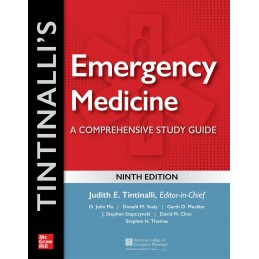- Obniżka


 Dostawa
Dostawa
Wybierz Paczkomat Inpost, Orlen Paczkę, DHL, DPD, Pocztę, email (dla ebooków). Kliknij po więcej
 Płatność
Płatność
Zapłać szybkim przelewem, kartą płatniczą lub za pobraniem. Kliknij po więcej szczegółów
 Zwroty
Zwroty
Jeżeli jesteś konsumentem możesz zwrócić towar w ciągu 14 dni*. Kliknij po więcej szczegółów
The long-awaited new edition of the worlds most widely used and highly regarded textbook and reference of emergency medicine
A Doodys Core Title for 2024 & 2022!
Tintinallis Emergency Medicine is THE essential resource for everyone working in, and teaching emergency medicine. The Ninth Edition provides the depth and breadth of coverage that reflects the complexity and expertise needed to practice emergency medicine in todays fast-paced environments. This comprehensive text is an important clinical resource for physicians, residents and students, advance practice providers, emergency nurses, EMTs, and paramedics. It is a necessary resource for in-training and board examinations, and recertification.
Tintinallis Emergency Medicine covers everything from prehospital care, disaster preparedness, and basic and advanced resuscitative techniques, to all the significant medical, traumatic, and environmental conditions requiring emergency treatment in adults, children and neonates.
Highlights of the Ninth Edition::
From the reviews of the seventh edition::
Collectively, they have once again produced an excellent text that manages to cover the broad scope of emergency medicine while remaining an easily readable and practical resource....Last, for the inevitable comparison of this current edition of Tintinallis Emergency Medicine with other available emergency medicine textbooks available:: in my opinion, Tintinallis still comes out on top. It is more concise and easier to read than some, yet it covers the breadth of emergency medicine practice more comprehensively than others….Just as previous editions did, the seventh presents all of the most pertinent and up-to-date information in a well-organized format that is comprehensive yet easy to read. That and many of the attractive new features in this current edition will ensure its place on my bookshelf for years to come.?JAMA
Opis
Indeks: 60012
Autor: James R. Roberts
Indeks: 91738
Autor: Robert Hockberger
2-Volume Set
